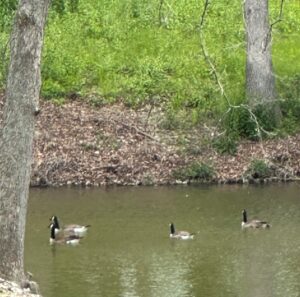Canada Geese – what is going on?
There is a big and obvious change in the Canada Geese on our small lake, the large lake which is about two miles from us, and the even larger lake about 30 miles from us.
miles from us.
There are no baby geese. No families.

For the 20 years we have lived here, our small lake has had a resident population of about 30-50 Canada Geese. The only time we do not have any geese is if the lake freezes solid which can happen for a week or 2 from mid-December through about mid-February. The ice is often thick enough that we do have a few ice fishermen. But once the ice melts, the geese always immediately returned. But this year, only a few returned. We have less than a dozen and there are days we have none.
 We have a prime nesting spot on the point of our land and this is highly contested each spring. For those of you who watched the bird feeder cam last March
We have a prime nesting spot on the point of our land and this is highly contested each spring. For those of you who watched the bird feeder cam last March and April, you will undoubtedly remember the Great Goose Wars. Generally 2 to 3 pairs of geese within camera range lunging at each other, chasing each other, actually pulling out a few tail feathers, and with the loudest honking imaginable. Day after day. This year, we had two pairs who had one or two half-hearted skirmishes but you could tell, their hearts were just not in it. Tepid tempers at best. And then both pairs simply left. Our prime nesting spot is vacant.
and April, you will undoubtedly remember the Great Goose Wars. Generally 2 to 3 pairs of geese within camera range lunging at each other, chasing each other, actually pulling out a few tail feathers, and with the loudest honking imaginable. Day after day. This year, we had two pairs who had one or two half-hearted skirmishes but you could tell, their hearts were just not in it. Tepid tempers at best. And then both pairs simply left. Our prime nesting spot is vacant.
By early to mid-May every year, we have had at least 3-4 families of geese on our small lake – anywhere from about 4-12 youngsters in each family. The parents bring the youngsters to the feeders and last year, you would have seen these families eating the seed Cleon scatters on the ground under those feeders on that livestream.
Across our small inlet is a large backyard similar to ours in that the house is surrounded on three sides by water. The difference is we do not mow to the edge of the lake. There is a 2-3 foot wide strip along our entire bank which is all black raspberries, Joe Pye Weed, Maximillian Sunflower, Golden Alexanders, Ironweed, Japanese Irises, assorted willows, oaks, hickories, a locust, and the dreaded poison ivy. There is only one opening for geese and ducks to enter from the lake and so we are limited in the number of geese we have in our yard. Our neighbors who mow to the edge of the lake on all three sides have a whole lot more. For all these years, every late spring and summer afternoon, their yard is full of 30 or more geese – all resting and preening. Their favorite bath spot is just off their point. This entire spring, there have only been 2-3 geese at a time in that yard – and most days, none at all. After the two pairs who were sort of pushing each other around over our nest spot, we have only had 1 or 2 geese a day at the feeders – and most days, none. As of today, no youngsters anywhere on our lake. It also appears there are no nests – we have used our scope and scanned the entire shoreline and we see no nesting geese. Normally, we can see at least 3-4 nests.

Two days ago, we drove over to the large lake that is close to us and observed 3 separate large flocks of geese – all in the grassy areas that surround this lake. Each flock was close to 70 geese and many were paired off We also observed several smaller flocks in the water. But there were no youngsters anywhere, and as this was the middle of the day and we watched each flock for some time, we are assuming none of these geese have nests. If that is true, this is a huge change. By now, this large lake has always had a dozen or more families. Yesterday we drove to the even larger lake about 30 miles from here and observed the same thing. Large flocks of geese in the grassy areas – many geese obviously in pairs, it was the middle of the day, we observed each flock for some time, and there was just no movement of any of these geese towards nests – none separated from the flock. We observed no families with youngsters anywhere around the lake or in the water. So what is happening? What has changed?
Here in central Illinois, Canada Geese can hatch young as late as mid-June so there are still about 3 weeks when we might start to see families with youngsters. But this is late – later than it has been as long as we have lived here. It is normal for us to see families with youngsters here as early as April 10th. It is eerie to look out on a rather empty lake! Have any of you observed this where you live? Pairs of Canada Geese, but no youngsters? Use the Public Forum to tell us about it. Or email me at: lindahendricksspence@birdingbeyondthefieldguide.com

